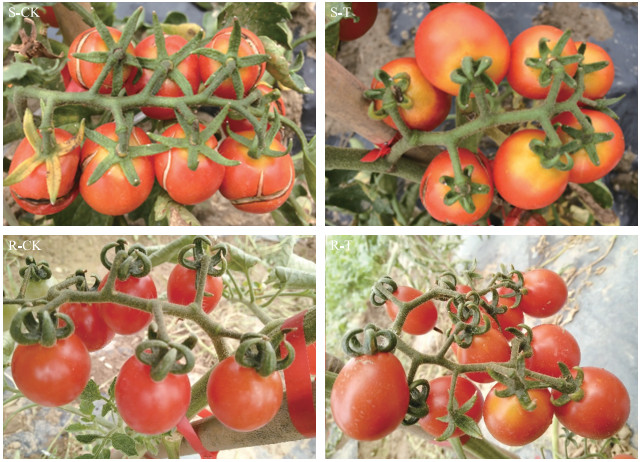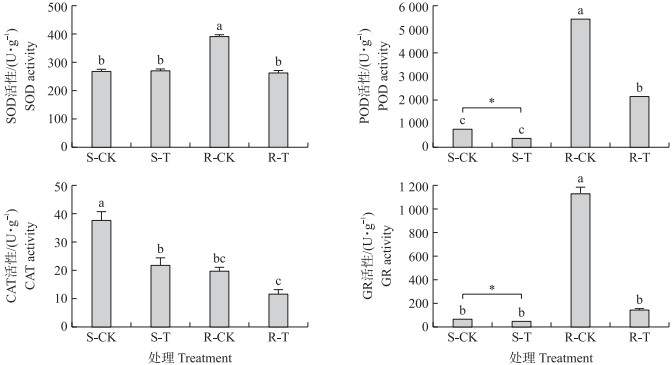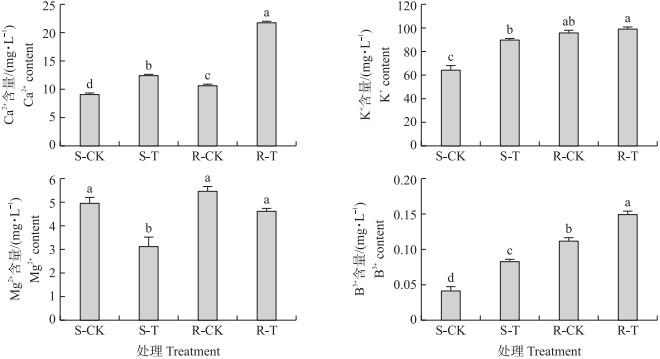文章信息
- 崔守尧, 吴震, 吕海萌, 薛灵姿, 蒋芳玲
- CUI Shouyao, WU Zhen, LÜ Haimeng, XUE Lingzi, JIANG Fangling
- 外源CaCl2缓解番茄裂果的生理机制
- The physiological mechanism of exogenous CaCl2 relieving tomato fruit cracking
- 南京农业大学学报, 2019, 42(1): 59-65
- Journal of Nanjing Agricultural University, 2019, 42(1): 59-65.
- http://dx.doi.org/10.7685/jnau.201802015
-
文章历史
- 收稿日期: 2018-02-08
裂果是指果实发育成熟过程中果皮开裂的现象, 是一种常见的生理病害。果实产生裂痕, 会影响外观品质, 且易传播病虫害, 使果实降低或失去商品价值[1-2]。裂果的防治是生产中亟待解决的重要问题。
研究表明, 在甜樱桃上喷施波尔多液后能够显著降低裂果率, 而波尔多液中的Ca2+被认为是防控果实开裂的主要作用因子[3-4]。Yang等[5]研究发现, 与易裂果番茄相比, 耐裂果番茄含有较高水平的Ca2+。李建国等[6]研究表明, 荔枝叶片钙含量与裂果率密切相关, 钙含量越高越容易导致裂果的发生。在采后处理中, 用CaCl2溶液浸泡甜樱桃, 樱桃吸收Ca2+而非Cl-, 并可以显著降低裂果率[7]。而Ca2+对番茄裂果的影响, 以及Ca2+如何缓解番茄裂果的研究还鲜见报道。
钙作为植物生长发育所必需的矿质元素, 参与植物生长发育的整个过程。它可以与细胞壁中的果胶结合形成果胶酸钙, 稳固细胞壁结构, 增强果皮机械强度, 从而使得果实抗裂能力增强[8]。Ca2+作为植物细胞中的第二信使, 参与植物生长发育与衰老的调控过程, 对环境信号刺激会产生敏感反应。当植物正常衰老或遭受到逆境时, 会引起植物体内Ca2+含量的变化, 同时产生一系列活性氧物质, 进而引起植物抗氧化系统的变化, 包括抗氧化酶和抗氧化物质[9-10]。赵晓美等[11]研究表明, 喷施一定浓度的钙可以提高西瓜叶片中过氧化物酶(POD)和超氧化物歧化酶(SOD)的活性。梁颖等[12]研究表明, 低浓度Ca2+可以提高水稻幼苗叶片的过氧化氢酶(CAT)活性。除了对细胞壁以及抗氧化系统产生影响之外, 钙还会对植物体内的其他离子产生影响, 如K+、Mg2+、B3+等, 它们与裂果均有密切的关系[5, 13]。
本研究以易裂番茄和耐裂番茄为材料, 喷施外源CaCl2溶液, 测定红熟期番茄的裂果率、果实抗氧化酶活性、细胞壁相关物质和相关酶活性以及相关离子含量, 旨在探究外源CaCl2调控番茄裂果的生理机制, 为番茄裂果的防治提供理论依据。
1 材料与方法 1.1 植物材料与培养供试番茄品种为'Tomato Cherry Lizzano’和'Tomato Grape Jelly Bean Red’, 经6代以上自交和选择, 筛选出易裂果自交系S243和耐裂果自交系R251。2个材料均为早熟、无限生长型, 生长势强, 果实为红色小果。
于2016年2月在南京农业大学园艺学院蔬菜生理生态实验室进行育苗。将经过消毒的番茄种子浸种催芽, 待胚芽突破种皮, 播于72孔穴盘中。育苗基质为有机基质(江苏镇江兴农有机肥有限公司), 幼苗置于光照培养箱中培养, 昼温和夜温分别为25 ℃和18 ℃。4月8日, 选取长势一致的秧苗定植于江苏省农博园试验基地, 采用宽窄行双行定植, 栽培畦宽90 cm、高40 cm, 沟宽60 cm、深40 cm。每畦定植2行, 宽行的行距为100 cm, 窄行的行距为50 cm, 株距为30 cm。设3个重复, 每个重复12株, 采用随机区组排列。植株采用单干整枝, 留5穗果摘心, 植株管理和病虫害防治按常规进行。
1.2 试验设计与处理试验前期对3种易裂番茄用0、2、5、10、20 g·L-1 CaCl2喷施处理, 结果表明10 g·L-1的CaCl2缓解裂果的效果最好。因此, 本试验设置2个处理:喷施清水(对照, CK)和喷施10 g·L-1 CaCl2溶液(T)。
于第2穗果坐果时(5月8日)开始处理, 至第4穗果进入红熟期(6月23日)时终止处理。用CaCl2溶液顺着植株自下而上喷施, 直至叶面和果面充分湿润并伴有水滴滴下, 每周处理2次, 分别在周二和周五的上午09:00左右。待处理完(6月24日)进行诱导漫灌(地面漫灌, 诱导果实开裂), 灌水处理后选取2~4穗果用于试验。
1.3 测定项目与方法6月25日, 统计番茄红熟期的总果数以及裂果数, 计算裂果率。裂果率=(裂果数/总果数)×100%。每个重复随机选取10株番茄, 取平均值为该处理的裂果率。
鲜样制备时, 取红熟期果实纵切, 去除种子和果浆, 保留果皮(中果皮和外果皮)称质量, 置于-80 ℃保存备用; 干样制备时, 将番茄红熟期果实样品105 ℃杀青15 min后, 保持70 ℃烘至恒质量, 最后将烘干的样品研磨呈粉末状, 过孔径250 μm的标准筛保存备用。
H2O2含量测定采用Chakrabarty等[14]的方法。丙二醛(MDA)含量测定采用Kumar等[15]的方法。电解质渗透率采用Bajji等[16]的方法。
SOD活性测定采用Beauchamp等[17]和Zhou等[18]的方法。CAT活性测定采用Aebi[19]的方法。POD活性采用Muñoz-Muñoz等[20]的方法。谷胱甘肽还原酶(GR)活性测定采用Wheeler等[21]的方法。
纤维素酶、多聚半乳糖醛酸酶(PG)活性以及纤维素和果胶含量均采用曹建康等[22]的方法测定。测定Ca2+、K+、Mg2+、B3+含量时, 每个样品称取0.1 g粉末, 加入3 mL硝酸微波消解30 min, 微波消解系统为Ethos T(意大利Milestone公司)。消煮完毕后用Optima 2100DV电感耦合等离子体发射光谱仪(美国Perkin Elmer公司)测定Ca2+、K+、Mg2+、B3+含量。
1.4 数据分析采用Excel 2016和SPSS 16.0软件进行数据分析和绘图。
2 结果与分析 2.1 CaCl2处理对番茄裂果率的影响由图 1可见:对照(CK)中的易裂番茄S243和耐裂番茄R251的外观差异明显, 裂果率分别为47.66%和10.71%, 且差异显著(P<0.05)。CaCl2溶液处理可以显著缓解易裂番茄的裂果现象, 使其裂果率降低至21.92%, 显著低于对照, 但耐裂果番茄的裂果率为7.66%, 与对照相比无显著差异。

|
图 1 CaCl2处理对耐裂果及易裂果番茄的影响 Fig. 1 The influence of CaCl2 treatment on crack-resistant and crack-susceptible tomatoes S:S243;R:R251;CK:对照Control; T:10 g·L-1 CaCl2处理10 g·L-1 CaCl2 treatment.下同。The same as follows. |
由图 2可知:在对照中, 易裂果番茄果皮中H2O2含量高达0.029 μmol·L-1, 显著高于耐裂果番茄; CaCl2处理后, 易裂果和耐裂果番茄果皮的H2O2含量均显著下降, 分别下降42.28%和36.47%。对照中易裂果番茄果皮的MDA含量比耐裂果番茄高62.78%, CaCl2处理后易裂和耐裂果番茄的MDA含量均显著下降, 分别降低58.13%和53.56%。对照中易裂果番茄果皮的电导率高于耐裂果, 而CaCl2处理后, 易裂果番茄的果皮电导率降低13.47%, 耐裂果番茄果皮电导率无差异。

|
图 2 CaCl2处理对番茄果皮H2O2和MDA含量以及电导率的影响 Fig. 2 Effect of CaCl2 treatment on contents of H2O2 and MDA and conductivity in tomato pericarp 不同小写字母表示差异显著(P<0.05)。下同。 Different small letters indicate significant difference at 0.05 level. The same as follows. |
由图 3可见:与对照相比, CaCl2处理的易裂果番茄果皮SOD活性无显著变化, 而耐裂果番茄显著下降。CaCl2处理后, 易裂果和耐裂果番茄果皮的POD活性均显著降低, 分别降低54.61%和60.51%。与对照相比, CaCl2处理后易裂果番茄CAT活性显著降低, 而耐裂果番茄CAT活性也降低, 但差异不显著。CaCl2处理后, 易裂果和耐裂果番茄的谷胱甘肽还原酶(GR)活性显著降低, 分别比对照降低28.82%和87.79%。

|
图 3 CaCl2处理对番茄果皮抗氧化酶活性的影响 Fig. 3 Effect of CaCl2 treatment on antioxidant enzyme activity in tomato pericarp *P<0.05. |
由图 4可见:对照的易裂果番茄果皮Ca2+含量显著低于耐裂果番茄; CaCl2处理后, 易裂果和耐裂果番茄果皮Ca2+含量均显著高于对照。易裂果番茄果皮的K+含量均低于耐裂果番茄; 与对照相比, CaCl2处理后易裂果番茄果皮K+含量增加40.02%, 且差异显著, 而耐裂果番茄无显著差异。对照的易裂果番茄与耐裂果番茄果皮的Mg2+含量无差异; CaCl2处理后, 易裂果番茄果皮中的Mg2+含量比对照降低了37.16%, 但耐裂果番茄与对照相比无差异。易裂果番茄果皮的B3+含量均显著低于耐裂果番茄; CaCl2处理后, 易裂果和耐裂果番茄果皮的B3+含量均显著高于对照, 分别增加99.76%和33.04%。

|
图 4 CaCl2处理对番茄果皮Ca2+、K+、Mg2+、B3+含量的影响 Fig. 4 Effect of CaCl2 treatment on Ca2+, K+, Mg2+, B3+ contents in tomato pericarp |
由图 5可知:对照的易裂果番茄果皮纤维素酶和多聚半乳糖醛酸酶(PG)活性显著高于耐裂果番茄; CaCl2处理后, 2种番茄的2种酶活性均比对照显著降低, 其中, 易裂果番茄的纤维素酶和PG活性分别降低83.64%和57.06%, 耐裂果番茄分别降低63.07%和30.21%。

|
图 5 CaCl2处理对番茄果皮纤维素酶和多聚半乳糖醛酸酶(PG)活性的影响 Fig. 5 Effect of CaCl2 treatment on activities of cellulose and polygalacturonase(PG)in tomato pericarp |
由图 6可知:易裂果番茄的果皮纤维素含量显著低于耐裂果番茄; CaCl2处理后, 易裂果和耐裂果番茄果皮纤维素含量显著增加, 分别比对照增加48.10%和42.56%。对照的易裂果番茄原果胶、可溶性果胶和总果胶含量均显著低于耐裂果番茄; CaCl2处理后, 2种番茄果实的可溶性果胶、原果胶和总果胶含量均显著高于对照, 易裂果番茄分别增加148.96%、59.44%和93.20%, 耐裂果番茄分别增加69.16%、53.75%和60.79%。

|
图 6 CaCl2处理对2种番茄果皮纤维素、可溶性果胶、原果胶和总果胶含量的影响 Fig. 6 Effect of CaCl2 treatment on contents of cellulose, soluble pectin, protopectin andtotal pectin in tomato pericarp |
本研究发现, 10 g·L-1外源CaCl2喷施番茄植株, 可以有效降低易裂果番茄的裂果率, 但耐裂果番茄对照和处理间差异不显著。这一方面可能是由于易裂果番茄对CaCl2处理更加敏感; 另一方面, 可能是由于耐裂果番茄本身裂果率低, CaCl2处理后裂果率只是略有降低。
张川等[13]和王保明等[23]研究发现, 番茄裂果可能与果皮的活性氧代谢紊乱、膜脂过氧化程度高、细胞凋亡有关。研究发现, 植物组织在遭受外界胁迫后, 活性氧物质增加, 引起抗氧化酶系统的响应, 当活性氧清除系统不足以清除过多活性氧, 导致MDA含量上升, 电导率升高[24]。段风琴[25]研究表明, 钙喷施处理可以明显提高枣果皮果肉中的SOD、POD和CAT活性, 降低H2O2含量。本试验中, CaCl2处理后, 番茄果皮中的H2O2、MDA含量以及电导率均下降, 相关抗氧化酶活性也降低, 说明喷施CaCl2可以显著降低番茄果皮的氧化伤害, 减轻膜脂过氧化程度, 稳定细胞膜结构, 缓解裂果的发生。这与段风琴[25]的研究结论不一致, 原因可能是喷施CaCl2后, 番茄果皮遭受的氧化胁迫程度较低, 不足以响应抗氧化酶清除系统; 也可能是由于抗氧化酶系统前期已清除了过多的活性氧物质, 而本试验测定时正处于下降阶段, 因此抗氧化酶活性显著降低。
研究表明, Ca2+和B3+与裂果关系密切, 两者均可以和细胞壁结合起到增加细胞壁的强度[26-27], 进而降低裂果率。王宁等[28]在对锦橙裂果的研究中发现, K+含量低会引起大量裂果。本试验发现, 10 g·L-1 CaCl2处理后, 番茄果实中Ca2+和B3+含量增加, 而K+和Mg2+含量在易裂果和耐裂果番茄中表现不同, 其中易裂番茄的K+含量增加, Mg2+含量降低, 在耐裂番茄中K+、Mg2+均未表现出显著差异。这说明在易裂番茄中K+的吸收受CaCl2处理影响更明显, 可以起到缓解裂果的作用。林兰稳[29]研究发现, 正常荔枝果皮中的Mg2+含量显著低于裂果果皮。本试验结果中, Mg2+含量在经过CaCl2处理后在易裂番茄中显著降低, Mg2+是否会影响果实开裂, 还需要进一步研究。
果实细胞壁强度会影响果皮机械性能, 是影响果实开裂的重要因素。杨为海等[30]研究表明, 细胞壁成分的含量变化受细胞壁水解酶活性的影响较大, 进而会影响到果皮机械性能的强弱, 与裂果关系密切。Yang等[5]研究发现, 在番茄进入转色期之后, 易裂品种的PG与纤维素酶活性显著高于耐裂品种。在锦橙中的研究也表明, 耐裂果品种的果皮细胞壁果胶和纤维素含量均高于易裂果品种[31-32]。在本研究中, CaCl2处理后, PG与纤维素酶活性均显著降低, 减少了番茄果皮细胞壁成分的降解, 增加了细胞壁强度, 进而降低裂果的发生。然而, CaCl2对番茄裂果过程中相关基因的表达能否产生影响以及产生何种影响还有待进一步研究。
| [1] |
Opara L U, Studman C J, Banks N H. Sunlight affects the incidence of internal ring cracking and other physical attributes of 'Gala' apples[J]. Journal of Tree Fruit Production, 1997, 2(1): 45-52. DOI:10.1300/J072v02n01_04 |
| [2] |
Khadivi-Khub A. Physiological and genetic factors influencing fruit cracking[J]. Acta Physiol Plant, 2015, 37(1): 1718. DOI:10.1007/s11738-014-1718-2 |
| [3] |
夏永秀, 廖明安, 邱利娜. 甜樱桃裂果与防治研究进展[J]. 中国果树, 2010(2): 55-59. Xia Y X, Liao M A, Qiu L N. Progress of sweet cherry fruit cracking and prevention research[J]. China Fruits, 2010(2): 55-59 (in Chinese). |
| [4] |
Rupert M, Southwick S, Weis K, et al. Calcium chloride reduces rain cracking in sweet cherries[J]. California Agriculture, 1997, 51(5): 35-40. DOI:10.3733/ca.v051n05p35 |
| [5] |
Yang Z, Wu Z, Zhang C, et al. The composition of pericarp, cell aging, and changes in water absorption in two tomato genotypes:mechanism, factors, and potential role in fruit cracking[J]. Acta Physiol Plant, 2016, 38(9): 215. DOI:10.1007/s11738-016-2228-1 |
| [6] |
李建国, 黄旭明, 黄辉白. 裂果易发性不同的荔枝品种果皮中细胞壁代谢酶活性的比较[J]. 植物生理与分子生物学学报, 2003, 29(2): 141-146. Li J G, Huang X M, Huang H B. Composition of enzymatic activity related to cell-wall metabolism in different litchi cultivars[J]. Journal of Plant Physiology and Molecular Biology, 2003, 29(2): 141-146 (in Chinese with English abstract). |
| [7] |
Wang Y, Long L E. Physiological and biochemical changes relating to postharvest splitting of sweet cherries affected by calcium application in hydrocooling water[J]. Food Chemistry, 2015, 181: 241-247. DOI:10.1016/j.foodchem.2015.02.100 |
| [8] |
刘铁铮, 徐继忠, 王连荣, 等. 水果裂果研究进展[J]. 河北林果研究, 2004, 19(3): 282-287. Liu T Z, Xu J Z, Wang L R, et al. Progress on the study of fruit cracking[J]. Hebei Journal of Forestry and Orchard Research, 2004, 19(3): 282-287 (in Chinese with English abstract). DOI:10.3969/j.issn.1007-4961.2004.03.019 |
| [9] |
陈硕, 陈珈. 植物中钙依赖蛋白激酶(CDPKs)的结构与功能[J]. 植物学通报, 2001, 18(2): 143-148. Chen S, Chen J. The structure and function of calcium-dependent protein kinases in plants[J]. Chinese Bulletin of Botany, 2001, 18(2): 143-148 (in Chinese with English abstract). DOI:10.3969/j.issn.1674-3466.2001.02.003 |
| [10] |
章文华, 陈亚华, 刘友良. 钙在植物细胞盐胁迫信号转导中的作用[J]. 植物生理学通讯, 2000, 36(2): 146-153. Zhang W H, Chen Y H, Liu Y L. Calcium action in signal transduction in plant cells under salt stress[J]. Plant Physiology Communications, 2000, 36(2): 146-153 (in Chinese with English abstract). |
| [11] |
赵晓美, 王红梅, 杨卫, 等. 钙对西瓜幼苗生长、光合特性及保护性酶活性的影响[J]. 北方园艺, 2012(14): 144-146. Zhao X M, Wang H M, Yang W, et al. Effect of different Ca2+ concentrations on the growth, photosynthetic characteristics, protective enzyme activity of watermelon seedling[J]. Northern Horticulture, 2012(14): 144-146 (in Chinese with English abstract). |
| [12] |
梁颖, 王三根, 李帮秀. 钙对离体水稻叶片和地上部衰老的影响[J]. 西南农业大学学报, 1997, 19(2): 121-125. Liang Y, Wang S G, Li B X. Influence of calciumon the isolated shoot and leaf of rice seeding[J]. Journal of Southwest Agricultural University, 1997, 19(2): 121-125 (in Chinese with English abstract). |
| [13] |
张川, 王亚晨, 崔守尧, 等. 耐裂果与易裂果番茄果实发育过程中果实组织衰老与裂果的关系[J]. 南京农业大学学报, 2016, 39(4): 534-542. Zhang C, Wang Y C, Cui S Y, et al. The relationship between fruit tissue senescence and fruit cracking in cracking-resistant and susceptible tomato during fruit ripening[J]. Journal of Nanjing Agricultural University, 2016, 39(4): 534-542 (in Chinese with English abstract). DOI:10.7685/jnau.201601035 |
| [14] |
Chakrabarty D, Datta S K. Micropropagation of gerbera:lipid peroxidation and antioxidant enzyme activities during acclimatization process[J]. Acta Physiologiae Plantarum, 2008, 30(3): 325-331. DOI:10.1007/s11738-007-0125-3 |
| [15] |
Kumar G, Knowles N R. Changes in lipid peroxidation and lipolytic and free-radical scavenging enzyme activities during aging and sprouting of potato(Solanum tuberosum) seed-tubers[J]. Plant Physiology, 1993, 102(1): 115-124. DOI:10.1104/pp.102.1.115 |
| [16] |
Bajji M, Bertin P, Lutts S, et al. Evaluation of drought resistance-related traits in durum wheat somaclonal lines selected in vitro[J]. Australian Journal of Experimental Agriculture, 2004, 44(1): 27-35. DOI:10.1071/EA02199 |
| [17] |
Beauchamp C, Fridovich I. Superoxide dismutase:improved assays and an assay applicable to acrylamide gels[J]. Analytical Biochemistry, 1971, 44(1): 276-287. DOI:10.1016/0003-2697(71)90370-8 |
| [18] |
Zhou W, Zhao D, Lin X. Effects of waterlogging on nitrogen accumulation and alleviation of waterlogging damage by application of nitrogen fertilizer and mixtalol in winter rape(Brassica napus L.)[J]. Journal of Plant Growth Regulation, 1997, 16(1): 47-53. DOI:10.1007/PL00006974 |
| [19] |
Aebi H. Catalase in vitro[J]. Methods in Enzymology, 1984, 105: 121-126. DOI:10.1016/S0076-6879(84)05016-3 |
| [20] |
Muñoz-Muñoz J L, García-Molina F, García-Ruiz P A, et al. Enzymatic and chemical oxidation of trihydroxylated phenols[J]. Food Chemistry, 2009, 113(2): 435-444. DOI:10.1016/j.foodchem.2008.07.076 |
| [21] |
Wheeler C R, Salzman J A, Elsayed N M, et al. Automated assays for superoxide dismutase, catalase, glutathione peroxidase, and glutathione reductase activity[J]. Analytical Biochemistry, 1990, 184(2): 193-199. DOI:10.1016/0003-2697(90)90668-Y |
| [22] |
曹建康, 姜微波, 赵玉梅. 果蔬采后生理生化实验指导[M]. 北京: 中国轻工业出版社, 2007. Cao J K, Jiang W B, Zhao Y M. Experiment Guidance of Postharvest Physiology and Biochemistry of Fruits and Vegetablles[M]. Beijing: China Light Industry Press, 2007 (in Chinese). |
| [23] |
王保明, 丁改秀, 王小原, 等. 枣果实裂果的组织结构及水势变化的原因[J]. 中国农业科学, 2013, 46(21): 4558-4568. Wang B M, Ding G X, Wang X Y, et al. Changes of histological structure and water potential of Huping jujube fruit cracking[J]. Scientia Agricultura Sinica, 2013, 46(21): 4558-4568 (in Chinese with English abstract). DOI:10.3864/j.issn.0578-1752.2013.21.019 |
| [24] |
Fobel M, Lynch D V, Thompson J E. Membrane deterioration in senescing carnation flowers[J]. Plant Physiology, 1987, 85: 204-211. DOI:10.1104/pp.85.1.204 |
| [25] |
段风琴.壶瓶枣裂果的钙素营养生理及施钙效果研究[D].太谷: 山西农业大学, 2016: 25-40. Duan F Q. Influence of calcium on fruit cracking of jujube 'Huping' and its physiological mechanism[D]. Taigu: Shanxi Agricultural University, 2016: 25-40(in Chinese with English abstract). http://cdmd.cnki.com.cn/Article/CDMD-10113-1017021547.htm |
| [26] |
Islam M Z, Mele M A, Baek J P, et al. Cherry tomato qualities affected by foliar spraying with boron and calcium[J]. Horticulture Environment and Biotechnology, 2016, 57(1): 46-52. DOI:10.1007/s13580-016-0097-6 |
| [27] |
李成忠.影响芍药花茎机械强度的生理机制研究[D].扬州: 扬州大学, 2013: 36-46. LI C Z. Studies on physiological mechanism affecting the mechanical strength of inflorescence stem in herbaceous peony(Paeonia lacdflora Pall.)[D]. Yangzhou: Yangzhou University, 2013: 36-46(in Chinese with English abstract). http://cdmd.cnki.com.cn/Article/CDMD-11117-1014362675.htm |
| [28] |
王宁, 秦煊楠. 矿质营养对锦橙裂果的影响[J]. 西南农业大学学报, 1987, 9(4): 458-462. Wang N, Qin X N. Effect of mineral nutrition levels on fruit splitting in Jin-cheng orange[J]. Journal of Southwest Agricultural University, 1987, 9(4): 458-462 (in Chinese with English abstract). |
| [29] |
林兰稳. 矿质营养对荔枝裂果率的影响[J]. 土壤与环境, 2001, 10(1): 55-56. Lin L W. Effects of mineral nutrition on fruit cracking rate of Litchi chinensis[J]. Soil and Environmental Sciences, 2001, 10(1): 55-56 (in Chinese with English abstract). DOI:10.3969/j.issn.1674-5906.2001.01.016 |
| [30] |
杨为海, 曾辉, 邹明宏, 等. 裂果发生与果皮细胞壁修饰的关系研究进展[J]. 热带作物学报, 2011, 32(10): 1995-1999. Yang W H, Zeng H, Zou M H, et al. An overview of the roles of cell wall modification in fruit pericarp cracking[J]. Chinese Journal of Tropical Crops, 2011, 32(10): 1995-1999 (in Chinese with English abstract). DOI:10.3969/j.issn.1000-2561.2011.10.040 |
| [31] |
温明霞, 石孝均. 锦橙裂果的钙素营养生理及施钙效果研究[J]. 中国农业科学, 2012, 45(6): 1127-1134. Wen M X, Shi X J. Influence of calcium on fruit cracking of Jincheng orange and its physiological mechanism[J]. Scientia Agricultura Sinica, 2012, 45(6): 1127-1134 (in Chinese with English abstract). |
| [32] |
Liu G D, Wang R D, Wu L S, et al. Differential changes in cell-wall content and boron and calcium concentration in Newhall navel orange grafted on two rootstocks differing in boron-deficiency responses[J]. Communications in Soil Science and Plant Analysis, 2015, 46(4): 439-453. DOI:10.1080/00103624.2014.997384 |



